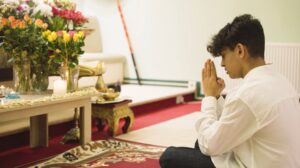Curriculum Mapping
Component 1: The study of religions - beliefs, teaching and practices: Buddhism - The nature, use and importance of Buddhist places of worship - Temples, shrines, monasteries (viharas), halls for meditation or learning (gompas) and their key features including Buddha rupa, artefacts and offerings.
Area of Study 3 – Buddhism - Section 3: Living the Buddhist Life - Features of Buddhist places of worship: the divergent nature, history and design of Buddhist places of worship, including temples, gompas, viharas, shrines in Theravada, Mahayana and Triratna Buddhism; how and why the places of worship are used, including reference to the shrine room, shrine facing east, and the library, showing the importance learning, including reference to the Kimsila Sutta. Puja: The nature and purpose of puja in the vihara and the home, including reference to Mangala Sutta; examples of the different types; when each type might be used and why; the importance of having different types of worship and their use in different Buddhist contexts.
Component Group 1–Beliefs and teachings & Practices - Buddhism-Practices - Sacred and significant places and spaces for Buddhists •The importance ,features and functions of: •• Temples •• Gompas and viharas •• Shrines •• Sites of pilgrimage •• Artefacts and offerings •• Retreats •The events that take place in different significant places, including Bodh Gayaand the Deer Park at Sarnath •The meaning and significance of key artefacts and offerings made at different significant places,includingthedifferentimages of the Buddha and his hand positions( mudras) • The purpose and form of retreats • The importance of undertaking pilgrimages • Common and divergent emphases placed on significant places and spaces by different Buddhist groups, including the role and importance of retreats •Different interpretations and emphases given to sources of wisdom and authority by different Buddhist groups
2.1 Unit 1 PART A - Part A - Buddhism - Core beliefs, teachings and practices - Practices Places of 'Worship' and Puja The importance of features and functions of a vihara/home shrine Diversity of practices in Theravada and Mahayana puja (Buddha, buddhas, bodhisattvas, mudras, mantras, mandalas) Dana (giving) – opportunity to make offerings of food to monks. Examples of the work of sanghas in Wales (Swansea, Cardiff, Raglan)
2.3 Component 3 (Route A) - Option 1: Buddhism - Practices - Buddhist places of worship in Britain and elsewhere ➢ The importance of features and functions of temples and viharas; statues, shrines, stupa and meditation area. Mahayana and Theravada Buddhist temples in Britain compared to those in countries where Buddhism is widely practised. ➢ Offerings: food, light, flowers, incense, offerings of food to monks (dana)
Transcript
Holy Cribs: The Vihara
Hivin: Hello and welcome to the London Buddhist Vihara. My name is Hivin and I'm a Buddhist. My religion is called Buddhism and our holy building is often called a temple, but the proper name for it is a vihara. And I'm going to show you around. Come on in. The first thing we do is take off our shoes and leave them on this rack. We do this to keep the inside of the building as clean as possible, as a symbol of purity. A vihara is a Buddhist monastery, a place where Buddhist monks live and we do have monks living here. The proper name for a monk is a bhikkhu. Bhikkhus are people who have decided to devote themselves into a spiritual life of simplicity and meditation. Come with me. This is a shrine room. It's the most important part of a vihara or any Buddhist temple. We come here to do puja, which means worship, and to meditate in front of a shrine which contains a statue of the Buddha. The Buddha is not a god. He was a man named Siddhartha Gautama, a royal prince who lived in Nepal about 2500 years ago. The title Buddha means enlightened one or awakened one because we believe that he discovered the truth about the world, how to live a happier and better life. We follow the Buddhist teachings, what we call the dhamma, and we give offerings of flowers, candles, incense, fruit and rice to a statue to show our respect for him. During puja, everyone sits on the floor as a sign of humility and equality. There might be clean sheets spread out on the floor or mats or cushions for people to sit on, so we are comfortable and ready to begin. We often chant words or phrases called sutras, which come from our holy books. This helps us to get into the right frame of mind for meditation, which is a very important part of Buddhism.
Meditation is concentrating or thinking deeply, and there are lots of different ways to do it. Meditation helps us to learn how our minds work so we can be like the Buddha and see the world for what it is and how to be happier. I can't control what goes on out there, but I can learn to control what goes on in here. We use bells to start or end a meditation and they can come in lots of different shapes and sizes. Like this bowl shaped one here. These are used because if I hit it. The sound goes on for ages, getting quieter and quieter, and I love it. It really helps me calm down and concentrate on my meditation. Buddhism has a lot of symbols to help us remember the dhamma, the Buddhist teachings, and to help us meditate. The eight spoked wheel is probably the most important and the best known. It's called the Dhamma Wheel, and it represents the noble Eightfold Path; eight principles that the Buddha taught us to live by: Right Understanding; Right Thought; Right Speech; Right Action; Right Livelihood; Right Effort; Right Mindfulness; and Right Concentration. This is a stupa. Really big ones are put up in places that are special to Buddhists, like where the Buddha was born or died or visited. Sometimes there are holy books or holy objects inside. For instance, things that used to belong to the Buddha, like clippings of his hair. Little stupas like this may also have something inside, but the shape itself has lots of different meanings. The eight rings around the top are another reminder of the Eightfold Path, which points towards the sky to symbolise the journey towards enlightenment. Which is when you know the truth about the world like the Buddha did. Some
Buddhists use a prayer wheel. It has sutras, words from a holy books, written around the outside and you hold the handle and spin it around. As it turns, the words are spread out into the air to bless everyone around. You sometimes get big ones to touch the walls or even turned by windmills or water wheels. Sutras are also written or printed onto flags which are hung up outside so that the wind can carry the blessings away to everyone. And we also have the stripey flag. The colours all have a meaning. Blue stands for peace and compassion. Yellow for the dhamma. Red for blessing. White for purity. Orange for wisdom. And all five together stand for unity. Mandala means circle or centre. Some Buddhists use these patterns to help them meditate. They are full of symbols with lots of different meanings. You see lotus flowers a lot in Buddhist art. Lotus flowers symbolise purity because they grow out of the mud at the bottom of lakes and rivers and float above it all, looking beautiful. It reminds us to be pure in an impure world. Welcome to our library. We have lots of holy books and books about the holy books. The most important are called the Tripitaka because that's where we find the teachings of the Buddha. My favourite is called the Dhammapada. These books were originally written in Pali, which was a language that used to be spoken during Buddha's time. And traditionally they were written on palm leaves. So we get these old odd shaped books with long, thin pages. And this is our meeting hall. We have lots of events here, like festivals and fundraisers for charity. Everything we do in the vihara is to help the Sangha, the community, and to support the bhikkhus who teach us and help us to become better Buddhists. Thanks for coming. You're welcome anytime. Bye.








